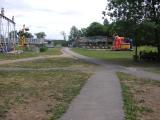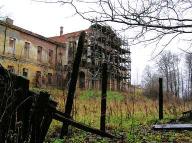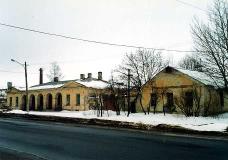Articles
/
Ropsha palace-and-park ensemble
Ropsha palace-and-park ensemble
Subject /
Architecture/Palaces
The Ropsha palace-and-park ensemble (the settlement of Ropsha, the Lomonosov District). It is a building of architectural and historic interest and landscape architecture art of the 18th century. It is one of palace-and-park ensembles that were created under Peter I on the southern coast of the Gulf of Finland. Ropsha is situated at an elevation of 80 metres above sea level. Lands at Knyazhya Mound were first belonged to Peter I who made here his summer retreat for using mineral springs. Subterranean springs discovered in Ropsha were used as the water sourse for fountains of the Low park of Peterhof. In 1714, Peter I granted Ropsha lands to Prince F.Yu. Romodanovsky, the "Caesar-Pope". The second estate in Ropsha was owned the State Chancellor G.I. Golovkin. In 1734 G.I. Golovkin's son Mikhail got married to Romodanovsky's granddaughter and became the owner of both estates and a new stone palace built according to the project of the architect P.M. Yeropkin. After the accession to the throne of Empress Elizabeth Petrovna G.I. Golovkin was exiled to Siberia, the estate was handed over the Treasury and became a tsar's residence. In 1748 the architect F. Rastrelli was entrusted with the palace redevelopment, general works were made from 1750 till 1756. Concurrently with the palace which was constructed in "Russian baroque" style, a landscape park with a water reservoir and cascade system, granite moorings and arched bridges, a fountain-grotto was laid out. In 1762 Peter III was confined and killed soon in the Ropsha Palace. In 1764 Catherine II presented the Ropsha estate to G.G. Orlov. For a long time the eastate was taken up by nobody and it fell into decay. In 1782 Orlov's heirs bought the estate to the court jeweller I.P. Lazarev who took up the reconstruction of the estate. Works were being made during 25 years. The regular garden was replaced with landscape English parks with the branched water system (designed by the engineer G.I. Engelman and the gardener T. Grey). According to the project of the architect Antonio Porta the palace was extended and built onto, two pavilions were built onto. Many famous architects - E.T. Sokolov, L.I. Ruska anf others - were recruited to works in Ropsha. A building of the Paper-mill was erected in 1787-1789 on the project of Yu.M. Felten. In 1801 Ropsha became the ownership of Paul I and till February 1917 it was the pleasure hunting and fishing estate of the tsar's family. After the revolution the estate was nationalized, in the palace a holiday home for the Party and executive leaders was placed. During the World War II Ropsha was occupyed, the palace was on fire, the park was digged with trenches and mined. During the period after the war in palace buildings a military unit was placed, during different periods an agricultural polytechnic school, a cattle-breeding state farm "Oktyabrsky", a fish farm, a Central experimental station at the Scientific Research Institute of Lake and River Fish Industry were placed in the estate. In the 1990s the restored palace was in fire two times. In 2004 the palace ensemble was included into the program "Revival, building, reconstruction and restoration of historic towns and cities of Russia in economic reform", that was implemented by the Government of the Russian Federation. On present days opportunities of using Ropsha as the centre of business tourism, of organizing museum exhibitions in the palace, exploratory works are carried out.
Authors
Chekanova, Olga Aleksandrovna
Persons
Catherine II, Empress
Elizabeth Petrovna, Empress
Engelman, Grigory Ivanovich
Felten, Yuri (George Friedrich) Maqtveyevich
Golovkin, Gavriil Ivanovich, Count
Golovkin, Mikhail Gavrilovich
Grey, Thomas
Lazarev, Ivan Lazarevich, Count
Orlov, Grigory Grigoryevich, Count
Paul I, Emperor
Peter I, Emperor
Peter III, Emperor
Porto, Antonio
Rastrelli, Francesco de
Romodanovsky, Fyodor Yuryevich, Prince
Rusca, Luigi
Sokolov, Yergor Timofeyevich
Yeropkin, Pyotr Mikhailovich
Geography
Topographical landmarks/Gulf of Finland, the
Topographical landmarks/Knyazhya Gora
Leningrad Oblast, the/Lomonosov District/Ropsha Settlement
Bibliography
Мурашова Н.В. Сто дворянских усадеб Санкт-Петербургской губернии: Исторический справочник. СПб., 2005., 296-301
Ропша. URL: http://www.lenobl.ru/culture/heritage/ropsha, 296-301
Subject Index
Paper mill
Mentioned in articles:
|
hidden
|
Lomonosov District
LOMONOSOV DISTRICT. Area: 1990.8 sq. km. Population: 65,300. Established in 1927. L. D. comprises Bolshaya Izhora and Lebyazhye urban settlements and 140 rural localities. It borders St. Petersburg and Kingisepp, Volosovo, and Gatchina Districts of... more
|
|
|
|
hidden
|
Parks
Park is a specially plan area with artificially planted trees and with the paths, trails, ponds. The first parks on the territory of the Leningrad Oblast were founded in the 18th century. They were part of imperial residences, grand prince... more
|
|
|
|
hidden
|
Protection of monuments of history and culture
The protection of history and culture monuments. Issues of the monuments protection are germane to the degree of their studying, right description and fixing. In Russia, the beginnings of interest in monuments of native antiquity were reflected in... more
|
|
|
|
hidden
|
Rastrelli, Francesko de (1700-1771), an architect
Francesko de Rastrelli (1700-1771), an architect, artist. The son of the Florentine sculptor Bartolomeo Rastrelli. During 1715-1725 F. Rastrelli worked with his father in St. Petersburg, then he learned in France. During 1730-1763 he served at the... more
|
|
|
|
hidden
|
Ropsha, settlement
ROPSHA, a village in Lomonosov District. Population: 847. Located on the Ropsha Heights near the Strelka River, at the crossing of the Kipen-Strelna highway and Dyatlitsi-Krasnoye Selo. The toponym originates from Novgorod’s name Khrap or Khrapsha.... more
|
|
|
|
hidden
|
Ruska, Luigi (1762 - 1822), an architect
Luigi Ruska (1762 - 1822), an architect. Ruska originated from Switzerland. In 1783 he arrived into st. Petersburg, he worked as a bricklayer with Yu.M. Felten, G. Quarenghi, F.I. Volkov, E.T. Sokolov, V. Brenna. He started working independently in... more
|
|
|
|
hidden
|
Sokolov, Yegor Timofeyevich (1750 - 1824), an architect
Yegor Timofeyevich Sokolov (1750 - 1824), an architect, practical builder. Sokolov was a apprentice, assistant and successor of the architect Yu.M. Felten. In St. Petersburg Y.T. Sokolov led the constructionof the main building of the Academy of... more
|
|
|











